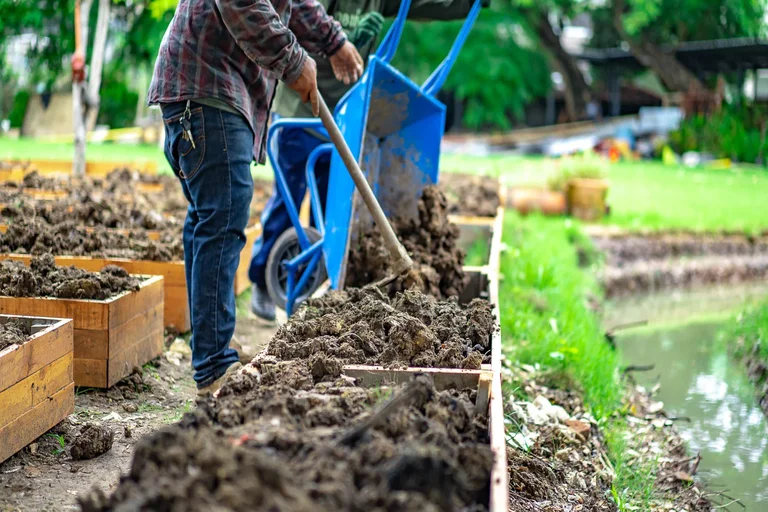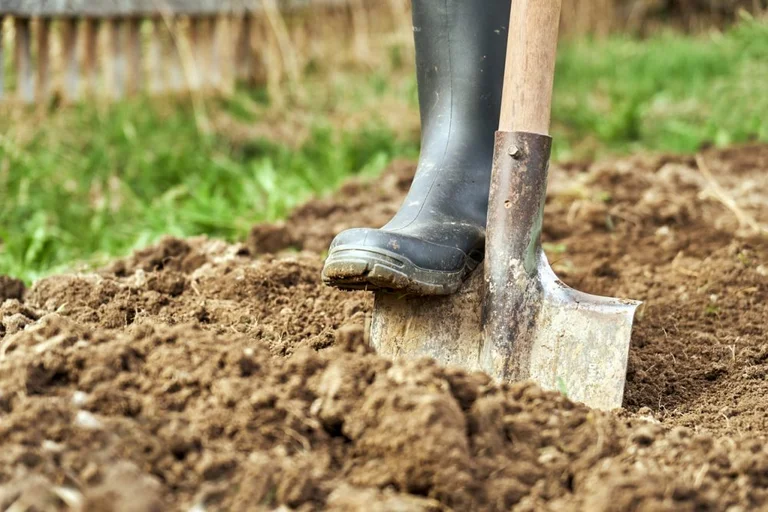
How To Improve Clay Soil For A Garden
If you’ve ever tried digging in clay soil, you know how tough it can be. It’s heavy, sticky when wet, and hard as rock when dry — making it difficult for roots to grow and for air and water to move freely. But don’t worry! You can improve clay soil for a garden with just a few smart changes. By adding organic materials, improving drainage, and managing it carefully, you can turn dense, hard clay into rich, healthy soil that your plants will love.
Clay soil is actually rich in nutrients, so it’s not a bad thing. The issue is that due to inadequate drainage and structure, these nutrients frequently remain “locked.” You can realize that potential and create a flourishing garden that consistently yields robust, colorful plants with the correct strategy.
Before learning how to fix it, it’s helpful to understand what clay soil actually is.
What Is Clay Soil?
The very small particles that make up clay soil are tightly bound together. This dense structure holds onto water longer than sandy or loamy soil. That might sound good at first, but it often leads to poor drainage and compacted ground, making it tough for roots to grow and breathe.

In simple terms, clay soil is:
1. Slow to drain: After rain, puddles can sit on top for hours or even days.
2. Sticky when wet and hard when dry, making it tough to dig or plant.
3. Nutrient-rich but poorly aerated: Roots may struggle to breathe
How to Identify Clay Soil:
Before you start trying to improve clay soil for a garden, it’s important to confirm that you actually have clay soil. You can often tell just by looking and feeling it. Clay soil feels smooth and sticky when it’s wet, and when it dries, it tends to crack or form hard clumps. If your garden stays waterlogged for long periods after rain or irrigation, that’s another clear sign you’re dealing with clay
Want a quick and easy way to check if you have clay soil? Try what gardeners call the “ribbon test.”
Just grab a small handful of moist soil and roll it between your fingers to form a strip or ribbon. If it holds together smoothly and bends without breaking, that means your soil has a high clay content. But if it crumbles apart or feels gritty, then it’s likely more sandy or loamy.
Best Ways to Improve Clay Soil for a Garden:
1. Add Organic Matter:
The best way to improve clay soil is by adding plenty of organic matter — and yes, this step makes the biggest difference.
Mix in materials like compost, well-rotted manure, or leaf mold. These help break up the heavy clay particles and create a looser, more workable soil structure. Once organic matter blends in, it boosts drainage and allows air to move freely through the soil, giving plant roots the oxygen they need to grow strong.
A simple routine? Add a few inches of compost to the top of your soil each season, then gently work it in. Over time, you’ll notice the soil becoming softer, healthier, and much easier to work with.
2. Use Cover Crops:
Cover crops are an excellent, natural way to loosen compacted clay soil — all while feeding it at the same time.
Plants like clover, rye, and buckwheat grow deep roots that gently push through dense clay, breaking it up and improving the soil structure. When you turn these plants back into the soil, they add rich organic matter that increases fertility.
Even better? Planting cover crops during the off-season helps prevent erosion and keeps your soil alive and active all year long. It’s a simple, low-effort method that delivers long-term benefits for your garden.
You can grow crop covers in the winter, such as buckwheat, rye, or clover. These promote organic matter, stop erosion, and enhance soil structure.
3. Avoid Working Clay Soil When It’s Wet — Here’s Why
If you try to dig or till clay soil when it’s wet, you could actually make things worse.
Wet clay compacts super easily, squeezing out all the air and forming rock-hard clumps. That makes it tough for roots to grow and for water to move through. So, always wait until the soil has dried out a bit before you start working with it.
Here’s a quick test: grab a handful of soil and squeeze it. If it forms a sticky ball, it’s still too wet. But if it crumbles lightly in your hand, it’s ready to go. Just following this one habit can save you months of frustration and extra work.
Wet clay soil is particularly susceptible to compression. In such situations, cultivating can destroy soil structure and produce clods.
4. Apply Gypsum:
Gypsum can be a great help for improving clay soil, particularly if your garden struggles with poor drainage or high sodium levels.
It works by breaking apart tightly packed soil particles, making it easier for water and air to move through. To use gypsum, just sprinkle a thin layer over your soil and gently mix it in.
But don’t go overboard; not all clay soils require gypsum. To get the best results, it’s a good idea to test your soil first or use gypsum sparingly in combination with lots of organic matter.
5. Mulching: The Simple Trick to Improve Clay Soil:
Mulching is one of the easiest and most effective ways to protect and improve clay soil.
Spread a thick layer of natural mulch—like straw, wood chips, or shredded leaves—over your garden. This keeps the soil moist without letting it get soggy. It also stops the surface from crusting and adds valuable organic matter as it breaks down.
By mulching regularly, you keep the soil soft, attract helpful earthworms, and create a healthier, happier environment for your plants’ roots to grow strong.
6. Choose Plants That Love Clay Soil:
While you’re working on improving your soil, pick plants that naturally handle clay well.
Perennials like daylilies, coneflowers, and black-eyed Susans don’t mind dense soil and will thrive. For veggies, cabbage, kale, and beans do pretty well in clay—especially if drainage is decent.
By choosing the right plants, you can enjoy a beautiful, healthy garden right now, even as your soil gets better over time with some care and patience.
Common Mistakes to Avoid When Improving Clay Soil:
Even the most dedicated gardeners make small errors that slow down progress when trying to improve clay soil for a garden. Avoiding these common mistakes will save you both time and effort — and help your soil recover faster.
One of the biggest mistakes is adding sand to clay soil. Many people think sand will make it looser, but in reality, it can turn the soil into something like concrete. Instead, always use organic materials like compost or leaf mold to improve texture naturally.
Another common error is working the soil when it’s too wet. Clay becomes compacted easily when handled at the wrong time, which makes it even harder for air and water to move through. Always check the moisture level first — slightly damp soil is perfect, but sticky, wet soil should be left alone until it dries a bit.
Many gardeners also forget to add organic matter regularly. One application isn’t enough; you’ll need to feed your soil every season to maintain structure and fertility. Think of it as a long-term relationship — your soil needs consistent care to stay healthy.
Lastly, avoid using chemical fertilizers too often. While they give a quick nutrient boost, they don’t improve soil structure or microbial life. Organic composts and natural amendments do both — they nourish your plants and keep the soil ecosystem alive.
By steering clear of these common mistakes, your journey to improving clay soil will be smoother, and your garden will respond with stronger, healthier growth.
How Long Does It Take to Improve Clay Soil:
Improving clay soil isn’t a quick fix — it’s a gradual process that rewards patience and consistency. Depending on how compacted or poor your soil is, it can take anywhere from one season to two years to see major changes. The key is to keep adding organic matter and maintaining good gardening habits over time.
In the first few months, you’ll notice small improvements such as easier digging and better drainage after rain. By the end of the first growing season, plant roots will start spreading more freely, and the soil will begin to feel lighter and crumbly. With each season of composting, mulching, and proper watering, your garden’s clay soil will continue transforming into rich, fertile ground.
Remember, improving clay soil for a garden is more like nurturing — not forcing. Every time you add compost, plant cover crops, or lay fresh mulch, you’re helping the soil rebuild itself naturally. Stick with the process, and soon your once-heavy soil will become a thriving foundation for a healthy, productive garden.
FAQS
Q1. How can I improve clay soil quickly?
Ans You can improve clay soil for a garden faster by adding a thick layer of compost and organic mulch, avoiding tilling when wet, and growing cover crops. These steps help loosen the soil naturally and boost fertility within a few months.
2. Is sand good for improving clay soil?
Ans. Not really. Mixing sand with clay can make the soil even harder. Instead, focus on compost, leaf mold, or well-rotted manure to improve structure and drainage safely.
3. Can I plant vegetables directly in clay soil?
Ans. Yes, but choose vegetables that can tolerate heavy soil, like cabbage, kale, or beans. At the same time, keep adding organic matter each season to gradually make the soil more garden-friendly.
4. How often should I add organic matter to clay soil?
Ans. For lasting improvement, add organic matter at least twice a year — once in spring before planting and again in fall after harvest. Regular additions keep your soil soft and nutrient-rich.
5. Does gypsum really help clay soil?
Ans. Yes, gypsum can help loosen clay soil, especially if it has poor drainage or high salt content. However, it works best when combined with compost and other organic materials for long-term results.
Related Article>https://www.climatechallange.com/how-healthy-soil-can-help-stabilize-weather-patterns/